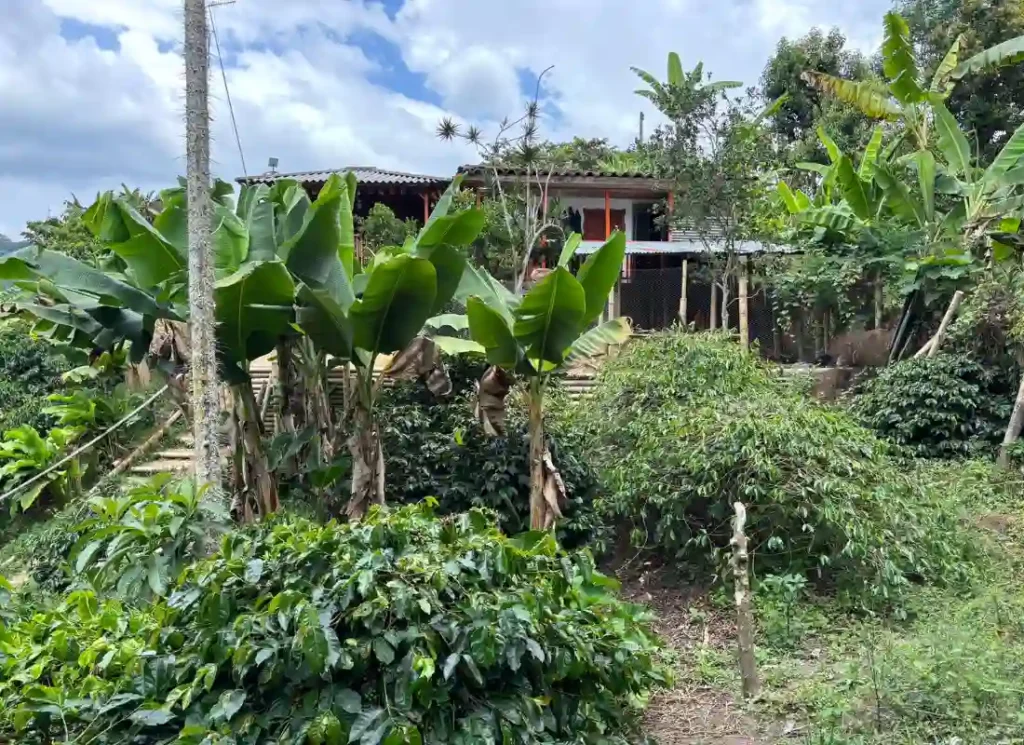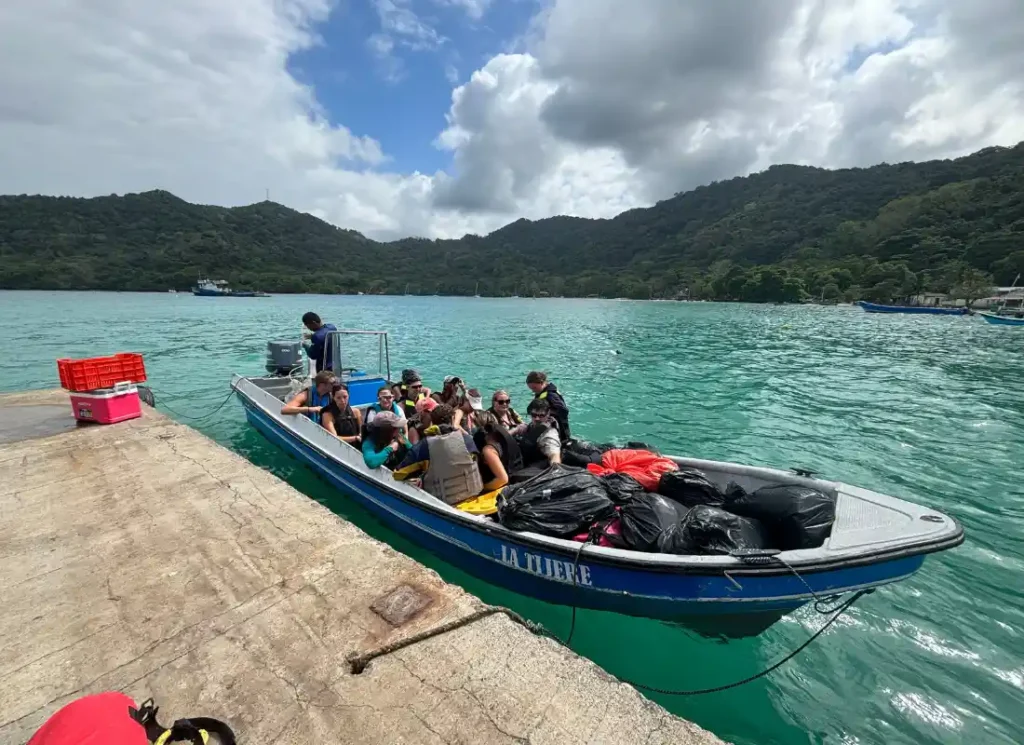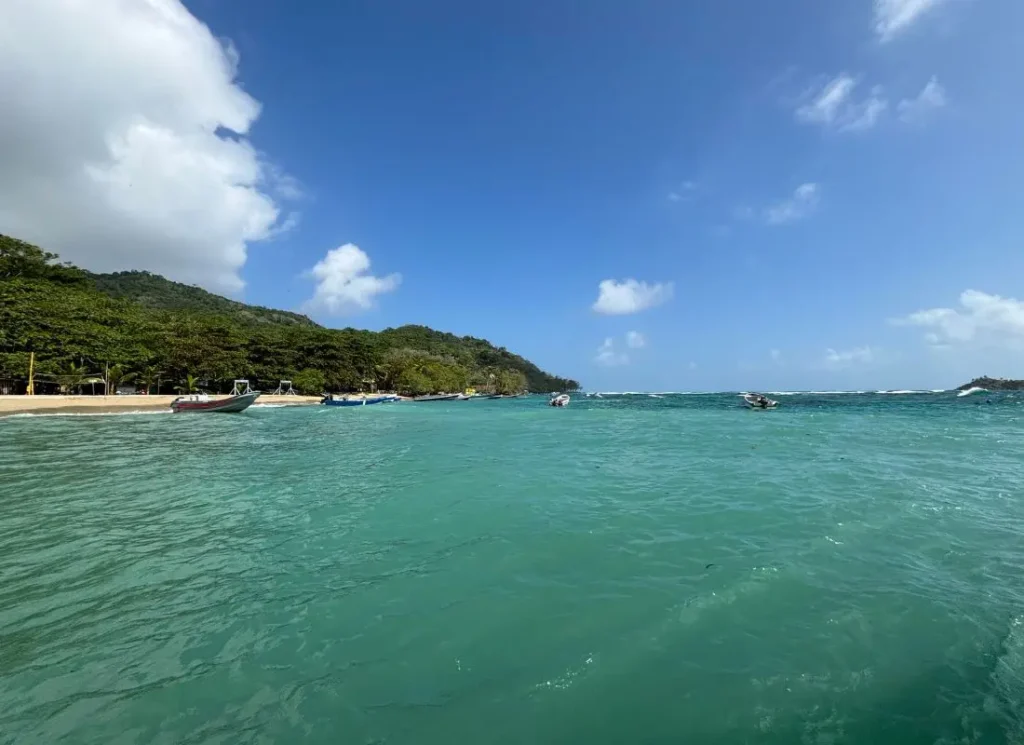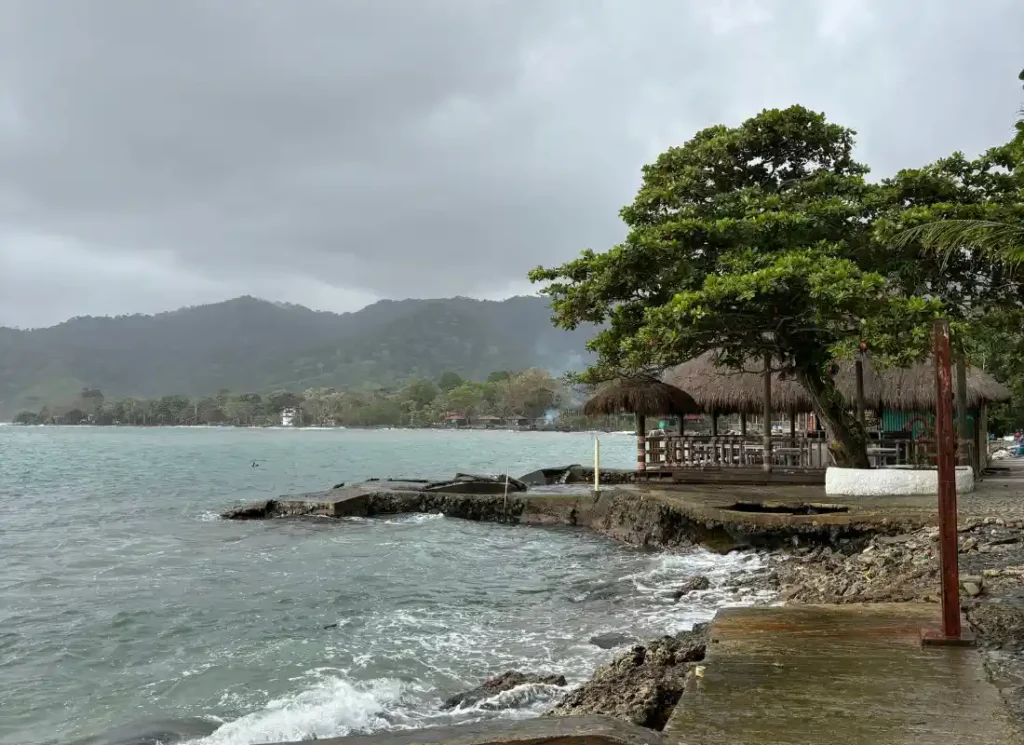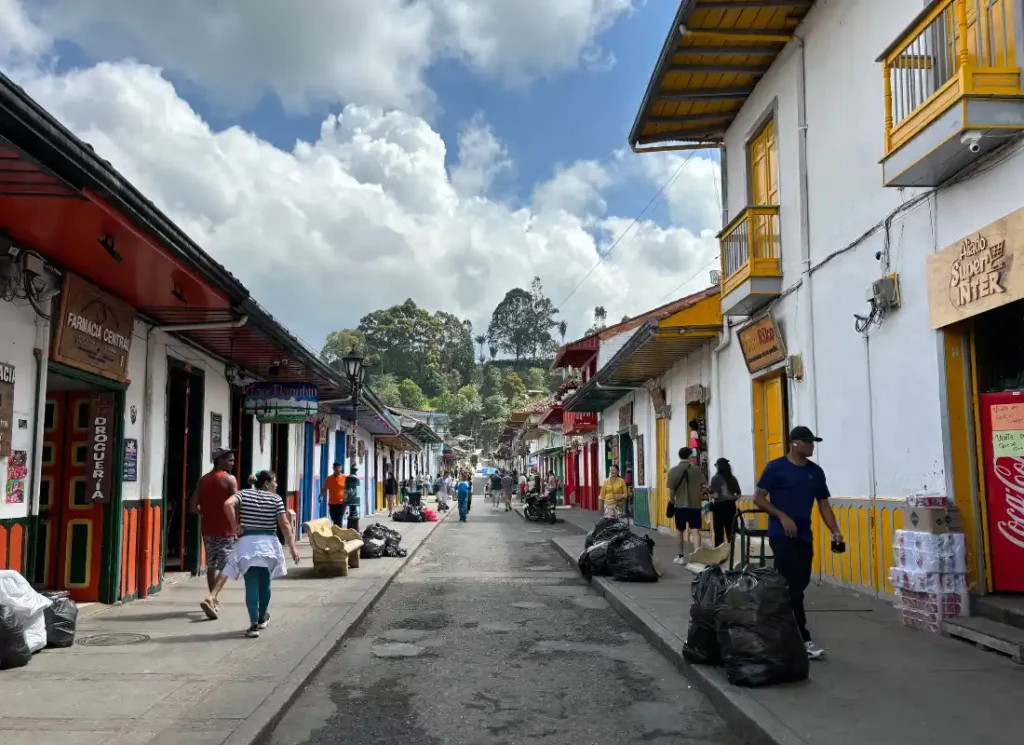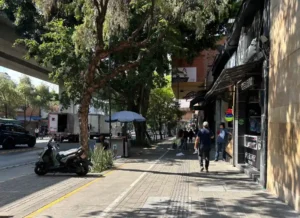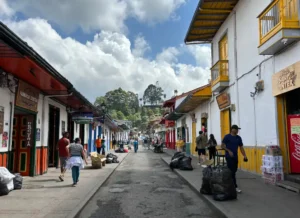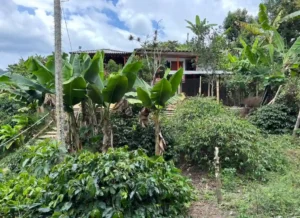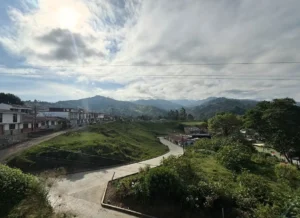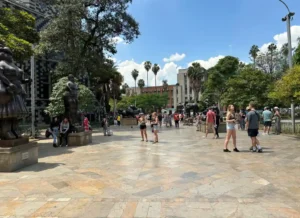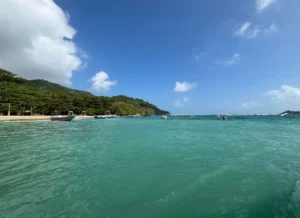Everything you need to know for your trip to Colombia! What’s the best time to go, and where can you find vegetarian or vegan food? What is the currency in Colombia, and do you need to protect yourself against mosquitos? And more questions answered about travelling in Colombia, South America in this ultimate guide.
📍Geography & Places to Visit in Colombia
Bogota
Bogota, the capital city of Colombia, is a great starting point for many travellers. This bustling metropolis offers a mix of colonial architecture and modern skyscrapers. Don’t miss the historic La Candelaria district, the Gold Museum, and a trip up Monserrate for panoramic views of the city. Bogota is also a perfect place to learn about Colombia’s turbulent history and vibrant culture.
Medellin
Once notorious for its association with the drugs trade and the he-who-shall-not-be-named of Colombia, Pablo Escobar, Medellin has transformed into one of the most innovative and welcoming cities in Latin America. It’s especially popular amongst digital nomads and immigrants, with the El Poblado district feeling more like a western colony than part of Colombia at all. Medellin is known as the “City of Eternal Spring” thanks to its perfect climate, and the temperatures in the city were actually reduced by 2 degrees after a huge effort to fill the city with trees and greenery which really bring the city to life.
🇨🇴 More on Medellin: A Guide to Neighbourhoods in Medellin
🇨🇴 More on Medellin: A Three-Day Medellin Itinerary
Cali
Cali is widely known as the salsa capital of the world and, whilst it’s not the safest city, the vibrant culture and uniqueness of the city more than makes up for it. Whether you’re practically a pro or a complete novice, you’ll learn something new dancing salsa caleña, a style of salsa rarely seen outside of Colombia. Whilst I completely and wholeheartedly recommend going to learn or watch salsa, even if you have never tried it before, if you’re dead against it then Cali probably isn’t worth a visit for you. Many areas of the city are too dangerous to see or visit, and most of the friends you make travelling in Cali will likely be heading off to a salsa class or show!
🇨🇴 More on Colombia: A guide to taking the bus from Cali to Medellin
Cartagena
Cartagena, on the Caribbean coast of Colombia, is supposed to be one of Colombia’s most picturesque cities. It is full of colourful colonial architecture, surrounded by ancient city walls, making it a photographer’s dream. Spend your days wandering the charming streets, relaxing on nearby beaches, or taking a day trip to many nearby islands.
Santa Marta
Santa Marta serves as a gateway to some of Colombia’s most beautiful natural attractions. It’s the jumping-off point for Tayrona National Park, known for its stunning beaches and lush jungle. The city itself offers a laid-back vibe, with a beautiful historic center and a seafront promenade. It’s also a great base for organizing treks to the Lost City (Ciudad Perdida).
Capurgana
For those seeking off-the-beaten-path adventures, Capurgana on the Caribbean coast near the Panama border is worth visiting. It’s not a common place to visit, but I have included it on this list because Capurgana is where I began my Colombian adventure, before travelling to Medellin via Necoclí. This small town offers beautiful beaches, great snorkeling and scuba diving opportunities, and a chance to experience a more authentic side of Colombia away from the major tourist routes.
🇨🇴 Read my complete guide to Capurgana here!
The Coffee Region
Colombia’s Coffee Region, also known as the Coffee Triangle, is a must-visit for coffee lovers and nature enthusiasts alike. This region, which includes the departments of Caldas, Risaralda, and Quindío, is home to lush green hills covered in coffee plantations. The small coffee town of Salento is a popular base for exploring the region (again, I mention Salento because it’s where I went, but there are many other towns to choose from), including the stunning Valle de Cocora, famous for its towering wax palm trees. It’s the perfect place to learn about the coffee-making process, stay on a traditional finca (farm), and enjoy some of the world’s best coffee.
🇨🇴 More on Colombia: How to Take the Bus from Salento to Cali
🌎 Colombia’s Borders
Colombia shares its borders with an impressive five Latin American countries, however most of them are not easily accessible or crossable for tourists (or anyone, really). Other than travelling via the land border with Ecuador (at the time of writing it is still closed due to political tensions in Ecuador, but it is generally open and safeish), the main way to travel in and out of Colombia is by plane.
Always check the latest travel advisories and border situations before planning any border crossings, and remember to get your passport stamped!
Colombia-Panama Border
The infamous Darien Gap makes land crossing between Colombia and Panama almost impossible. I did read a book about a guy who did it, but that’s how difficult it is to do: he wrote an entire book about the trek. The easiest way to travel between Panama and Colombia is by plane, but you can also take a sailboat or speedboat from Panama to Colombia. (And that’s how I ended up beginning my Colombian adventure in Capurgana).
Colombia-Venezuela Border
Due to political tensions, this border is often closed or unstable. It’s best to avoid crossing this border or, honestly, going anywhere near it.
Colombia-Brazil Border
This border crossing is deep in the Amazon rainforest and not commonly used by tourists, however, it can be done. The only issue is that you first have to take a flight to the very south of Colombia, which makes it a bit pointless if you’re trying to cross land borders to avoid flying! Somebody I met on my trip entered Brazil this way and then sailed down the Amazon river for five days in a hammock with some locals to arrive in Peru, but that was one step too adventurous for my solo trip..!
Colombia-Ecuador Border
As I mentioned above, this is a popular border crossing for travellers moving between the two countries, however the border closed about a month before I was due to cross, and it still hasn’t reopened. Now, when I say “closed”, it’s not technically closed, but in order to cross you need to provide an original copy of a criminal record certificate for every country you’ve lived in for the last five years, translated into Spanish by a certified translator and legalised with the Hague Apostille. Now, not only would that cost you several hundred dollars, but you’d also have to then find somebody to take you across the border, because I can tell you for sure that most busses are no longer running. (Not to mention, I’ve lived in three different countries in the last five years).
Colombia-Peru Border
There is only one way to cross this border, and like I mentioned above, it technically involves going via Brazil (although you don’t generally stamp your passport, so technically it’s a Colombia to Peru crossing. The rest of the border is swamped by the Amazon Rainforest and is uncrossable.
🌦 Weather in Colombia & When to Go
Touristy Seasons in Colombia
Colombia doesn’t have a distinct high and low season like the more southern parts of South America. However, the busiest times for tourism are typically during the dry seasons (December to March and July to August), which coincide with holiday periods in North America and Europe. Rather than differences in temperature (the temperature differs between cities depending on their altitude more than between seasons), the distinct rainy and dry seasons mark the passage of the year.
Rainy Season in Colombia
The rainy season generally runs from April to May and October to November. However, remember that Colombia’s diverse geography means that weather patterns can vary significantly depending on the region, so always check before you travel. For example the Amazon rainforest experiences high rainfall year-round.
Dry Season in Colombia
The dry season, which runs from December to March and July to August, is generally considered the best time to visit Colombia. However, even during these months, some rain can be expected in areas like the Amazon and the Pacific coast. Also, even during the dry season, the Caribbean coast is hot and humid, but tends not to be rainy.
Best Time to Visit
The best time to visit Colombia depends on your specific plans. For beach destinations like Cartagena and Santa Marta, the dry season (December to March) is ideal. If you’re planning to explore the Coffee Region or go hiking, the shoulder seasons (April-June or September-November) can be great, because there are fewer tourists and the landscapes are turning greener.
Sunrise & Sunset in Colombia
Being close to the equator, Colombia has a pretty consistent sunrise and sunset throughout the year. In most parts of the country, the sun rises around 5:30-6:00 AM and sets around 5:30-6:00 PM, giving you plenty of daylight for activities. For me, as a European, it was strange to feel warm weather and have the sun set so “early” because here in Europe the sun sets between 9-11pm during the summer. You quickly get used to it, though!
🚍 Getting Around & Public Transport in Colombia
Buses
Buses are the most common form of long-distance transport in Colombia. They’re generally comfortable, affordable, and a great way to see the country’s landscapes if you travel by day. When I was travelling in Colombia I generally took overnight buses between cities to save on accommodation costs and to make the most of my daytimes. I have a written fair few Colombia travel guides on these buses based on the route I took:
The cheapest way to book bus tickets is usually at the station itself, as you get the best range of departure times and prices. However, if you want to book in advance, I recommend using an online service like RedBus or BusBud because they have more reliable customer service than bus companies own websites.
🚌 Book your tickets with: BusBud
*Just so you know, we sometimes make a small commission on purchases made through some links on this website, at no extra cost to you.
Flights
Colombia is a pretty big company, and due to its lack of highways it can take a long time to travel around by bus. I always prefer to take buses over planes because it’s better for the environment, but they can hugely reduce your travel time. Airlines in Latin America as a whole are safe and reliable, just like in other parts of the world, and domestic flights are usually very reasonably priced.
Taxis and Ride-sharing
Taxis are widely available in Colombian cities, but it’s best to use ride-sharing apps like Uber or Cabify for safety and to avoid overcharging. In smaller towns, motorcycle taxis (moto-taxis) are common, but they can be quite dangerous (obviously depending on your driver). Uber is technically illegal in Colombia, so its customary to sit in the front seat as though you’re a friendly passenger. However, it is safe to use, and much safer than taking a random cab from the street. I would only recommend taking a cab from outside of a bus station, airport or similar, and even then, be vigilent!
Metro and Public Transport
Medellin boasts the only metro system in Colombia, which is clean, very safe, and a great way to get around the city. Other major cities have extensive bus systems; don’t be afraid to ask questions and trust the locals to tell you whether or not something is safe to do.
Colectivos
These shared minivans or jeeps are a common sight in rural areas and are often the best way to reach smaller towns or natural attractions. In some cities, like Cali, I never would have dared to get on one because they seemed really dangerous. However in Capurgana (full of friendly locals) and Salento (full of tourists), they felt much safer. Trust your instincts, and if in doubt, don’t get on.
🍽 Food in Colombia
Vegetarians & Vegans
Traditional Colombian cuisine is pretty meat-heavy, however vegetarian and vegan options are becoming more common, especially in major cities and touristy areas. In Bogota and Medellin, you’ll find a growing number of vegetarian and vegan restaurants. In smaller towns, you might need to be more creative, but staples like rice, beans, plantains, and fresh fruits are always available.
Is Street Food Safe?
Street food is a part of Colombian culture and is a great way to experience local flavours. Generally, it’s safe to eat, but use common sense: look for busy stalls with high turnover, avoid anything that looks like it’s been sitting out for a while, and stick to cooked foods (avoid salads, fruit, etc. unless you can see that it’s been washed with drinking water).
Can You Drink Tap Water in Colombia?
Tap water is generally safe to drink in major cities like Bogota, Medellin, and Cartagena. However, in rural areas and smaller towns, it’s best to stick to bottled or filtered water. When in doubt, ask your accommodation. I found that in Central America, accommodation would provide drinking water if the tap water wasn’t safe, however that wasn’t the case throughout South America. If you’re not sure, ask a local, and if in doubt, drink sealed bottled water.
🤟 Languages in Colombia
What Languages Do They Speak in Colombia?
Spanish is the official language of Colombia and is spoken throughout the country. There are also over 60 indigenous languages spoken in various regions, particularly in the Amazon rainforest area.
Do People Speak English in Colombia?
English proficiency in Colombia is generally low, especially outside of major cities and tourist areas. In places like Bogota, Medellin, and Cartagena, you’ll find more English speakers, mostly within in the tourism industry. Colombia was the one country in which I was consistently speaking Spanish, both out and about and with the other people staying in my hostel. However, in more touristy areas like El Poblado in Medellin and on the Caribbean coast of Colombia, you are more likely to find English speakers.
💵 Money & Currency in Colombia
What is the currency in Colombia?
The currency in Colombia is the Colombian Peso (COP). Be prepared for large numbers – at the time of writing, 1 USD is equivalent to about 4,200 COP (but always check the current exchange rate before you pay for anything).
How much does it cost to withdraw money in Colombia?
ATMs are widely available in cities and towns. Most will charge a fee for international cards, typically around 10,000-15,000 COP (about $2.50-$3.75 USD). I had real issues withdrawing money in Colombia, both with Monzo and Revolut. Whilst I didn’t have issues in any other country with these cards, the customer service I got, especially from Monzo, caused me to permanently switch banks, and now I only ever use Wise.
💵 Head over to: Wise Bank
Do they take card in Colombia?
Credit and debit cards are widely accepted in cities and tourist areas, particularly in hotels, restaurants, and larger shops. However, for small purchases, street food, or in rural areas, you will need cash. It’s always a good idea to have some cash on hand, both for emergencies and when visiting smaller towns or markets. I always made sure I had plenty of COP, and throughout my entire trip I kept an emergency $100 USD in cash which saved my ass on several occasions!
⛑ Safety and Medical Care in Colombia
Tourist Areas & the Tourist Trail
Colombia has made great strides in safety over the past couple of decades, but it’s still important to exercise caution. Stick to well-trodden tourist areas, especially when you’re first getting to know the country. Popular destinations like Cartagena, Medellin, and Bogota are generally safe for tourists, but listen to the locals and listen to your gut; there are dangerous areas of almost every city in the world. Stay vigilent, and don’t walk alone at night.
Pickpockets
As with most places, pickpocketing can be an issue in crowded areas in Colombia. Keep your valuables secure, use a money belt, and be extra vigilant in busy markets, on public transport, and in popular nightlife areas.
Violent Crime
While Colombia’s reputation for violent crime has improved significantly, it’s still important to be cautious. Avoid walking alone at night, particularly in unfamiliar areas. Use Uber or Cabify instead of hailing cabs on the street or taking a bus, especially at nighttime.
Taking a Local Guide
For certain activities, like trekking to the Lost City or exploring remote areas of the Amazon rainforest, it’s not just a good idea to take a local guide – it’s essential. Local guides can provide valuable insights, ensure your safety, and help you have a much more enriching experience. I generally recommend taking a local guide even where not totally necessary, if you can afford it, because you’re almost guaranteed to have a better experience and you can give back to the local economy at the same time.
Can you drink the tap water in Colombia?
As I mentioned earlier, tap water is generally safe in major cities but may not be in rural areas. When in doubt, go for bottled or filtered water.
Travel Insurance & What to do if you get ill
Travel insurance is absolutely essential for any trip to Colombia. While healthcare in major cities is generally good, it can be expensive for foreigners. Unless you’re emergency-level ill, a pharmacy is usually a good first stop for minor ailments. Many medications that require prescriptions in other countries are available over the counter in Colombia. For more serious issues, your best option is heading to a private clinic in a major city if possible.
I’ve currently decided not to recommend a particular health insurance company, because I’ve never claimed on it myself therefore I can’t tell you if it’s any good or not.
Mosquitos
Dengue Fever
Dengue fever is present in Colombia, particularly in lowland and coastal areas. Use mosquito repellent, wear long sleeves and pants where you can (sometimes it really is just too hot), and consider using a net over your bed, especially if you’re staying in budget accommodations, or accommodation without air conditioning.
Yellow Fever & the Yellow Fever Vaccine
Yellow fever is a risk in some parts of Colombia, particularly in rural areas below 2,300 meters, including Capurgana, a destination I like to recommend. Some areas, including parts of the Amazon, require proof of yellow fever vaccination for entry. Either way it’s a good idea to get the vaccine before your trip, especially if you plan to visit rural or jungle areas.
Malaria
Malaria is present in some parts of Colombia, again including Capurgana and parts of the Amazon rainforest. Check the status of where you’re going before you travel, and consider taking anti-malarial medication if you’re planning to visit these regions. Because I did a long trip travelling in and out of malaria zones, my doctor decided to give me a malaria treatment to start taking if I ever got a fever in or after a malaria area. Luckily for me I don’t tend to get bitten much by mosquitos anyway, so I preferred this option to constantly taking anti-malaria medications.
Remember, Colombia is a diverse and beautiful country with much to offer. By staying informed and taking sensible precautions, you can have a safe and unforgettable journey through this amazing South American destination.
- A Full Guide to the Boat from Panama to ColombiaThis guide takes you through three ways to get from Panama to Colombia by boat, weighing up the pros and cons of each option!
- A Three Day Itinerary for MedellinIn this three day itinerary for Medellin I have created a varied, adaptable plan that anyone can use to build their perfect three days in Medellin.
- How to Take the Bus from Cali to MedellinHow to take the day bus or overnight bus from Cali to Medellin; Cali, the vibrant birthplace of Colombian Salsa, to Medellin, the city of eternal spring.
- How to Take the Bus from Salento to CaliHow to take the bus from Salento to Cali; Salento, the valley of coffee and palm trees, to Cali, the vibrant and colourful birthplace of Colombian Salsa.
- The 12 Best Hotels and Hostels in SalentoAll recommendations of where to stay in Salento come from real people. They’re places that I’ve visited, heard from a friend or been recommended by a local.
- How to Take a Coffee Farm Tour in SalentoSalento is a small town in Colombia’s coffee region. I run through the coffee fincas you can find in Salento, how to choose the right one, and how to get there.
- How to Get from Medellin to Salento by BusHow I got stranded with nowhere to stay on the empty streets of Salento at 2am (and how to make better decisions than us on the bus from Medellin to Salento).
- Where to Stay in Medellin, Colombia (Best Areas, Hotels and Hostels)In this article, I’m going to go through the best places to stay in Medellin, Colombia and give you my top picks for hotels and hostels.
- A Guide to Neighbourhoods in Medellin for Tourists and LocalsHere’s my guide to Neighbourhoods in Medellin, Colombia, one of the top spots (if not THE top spot) for tourists, digital nomads and immigrants in Colombia.
- Everything to Know About Capurgana, ColombiaEverything you need to know about Capurgana: where to stay, what is the vibe like, how to get there and things to do in Capurgana, Colombia
- How to Take the Boat from Capurgana to NecocliEverything to know about taking the boat ride from Capurgana to Necocli, Colombia: where to buy tickets, where to get on the boat, and how wet is the ride!
- 3 Ways to Get from Capurganá to MedellínHow to get from Capurgana to Medellin by bus, car, or plane. Plus, hear the story of how me and my friends got scammed by the promise of a private transfer…


